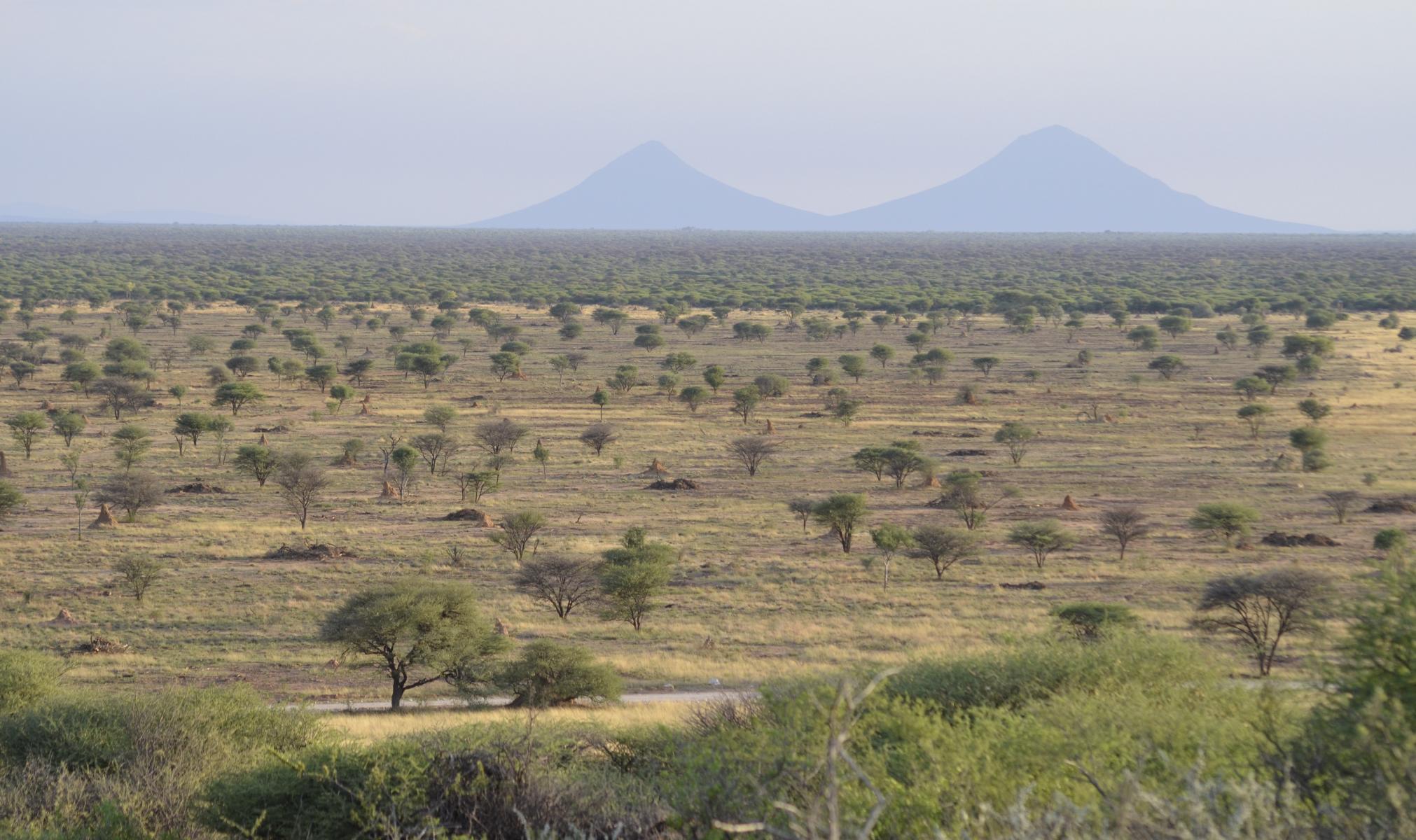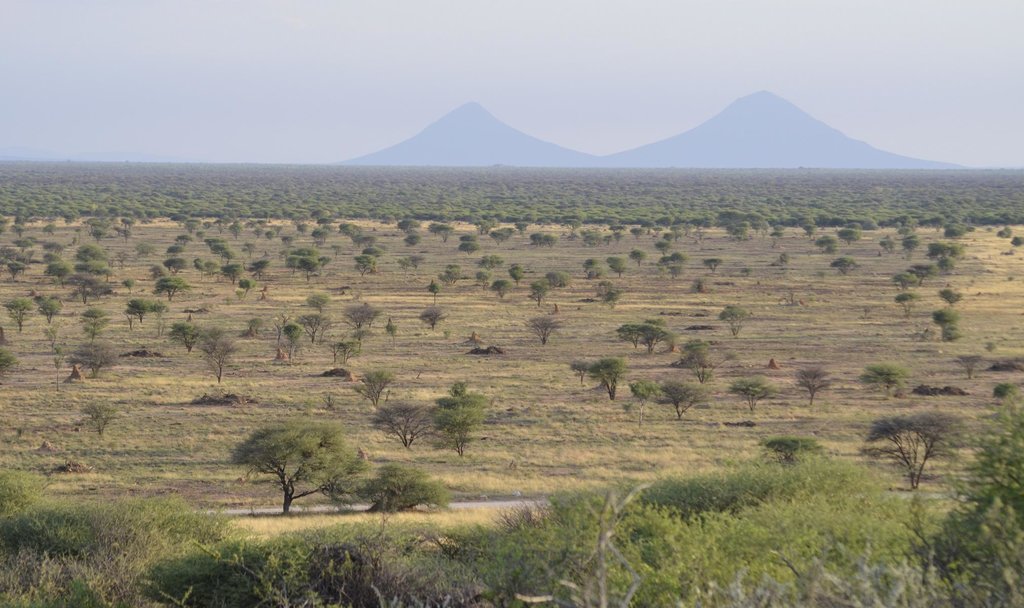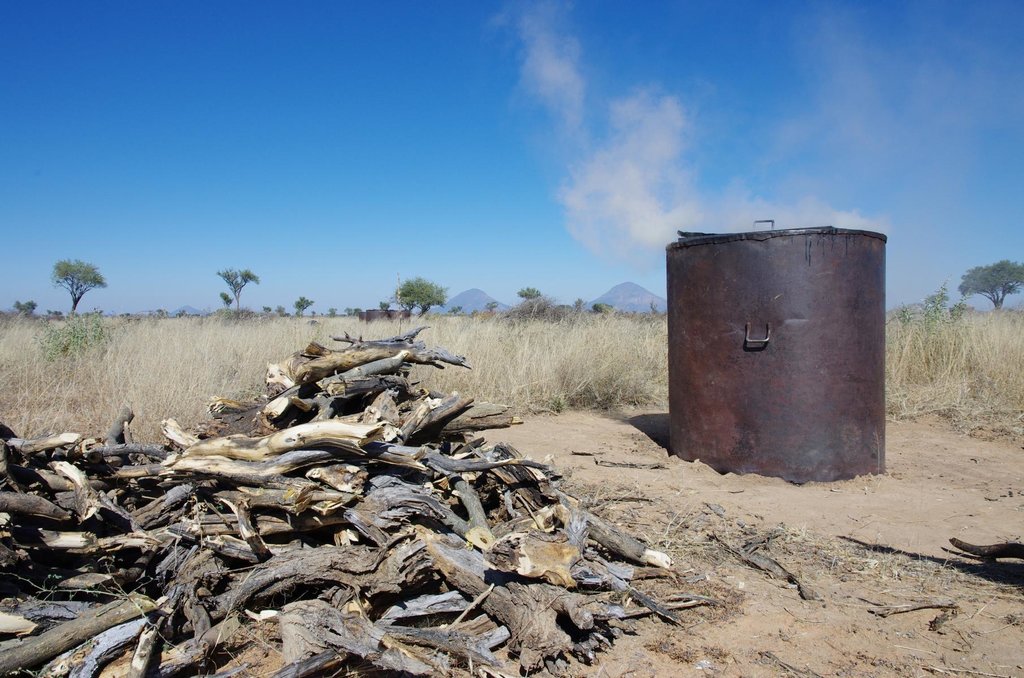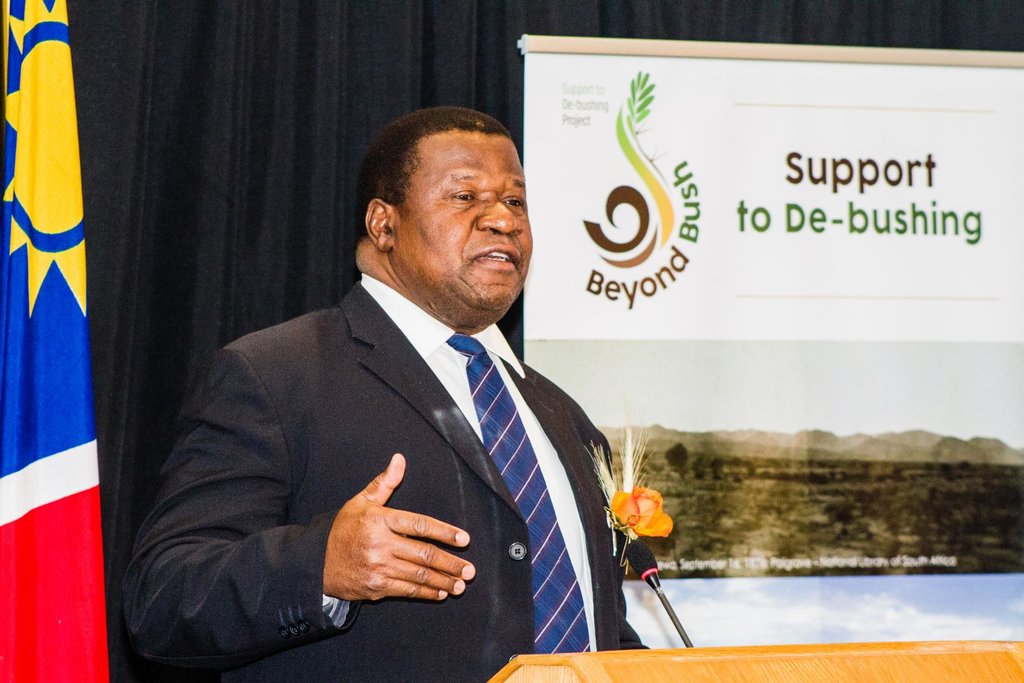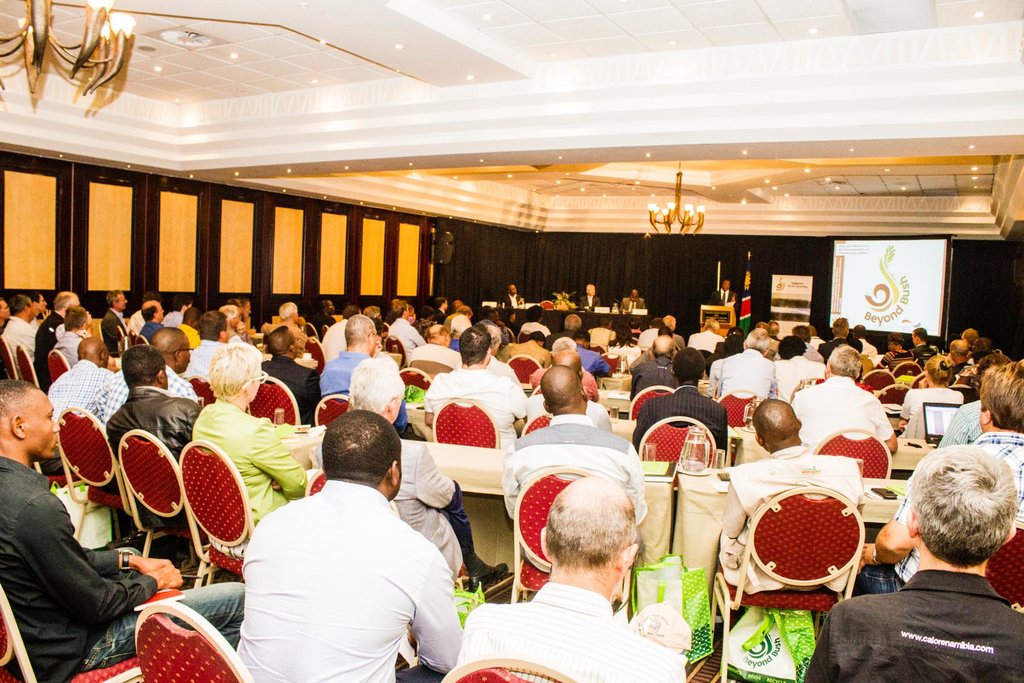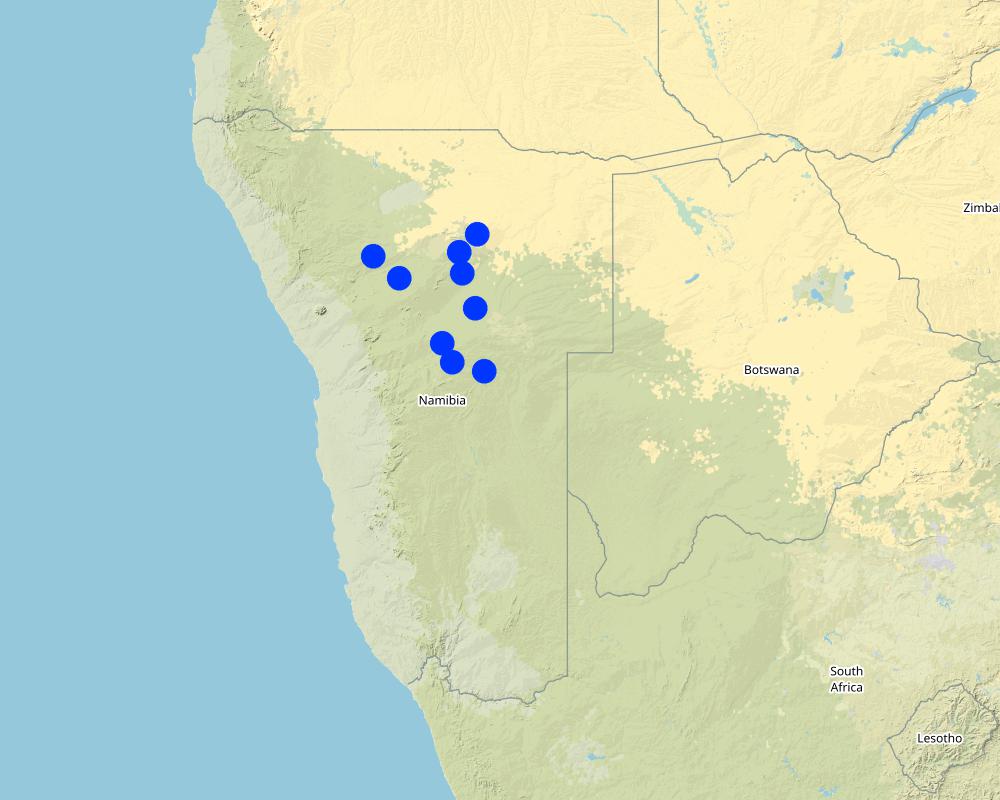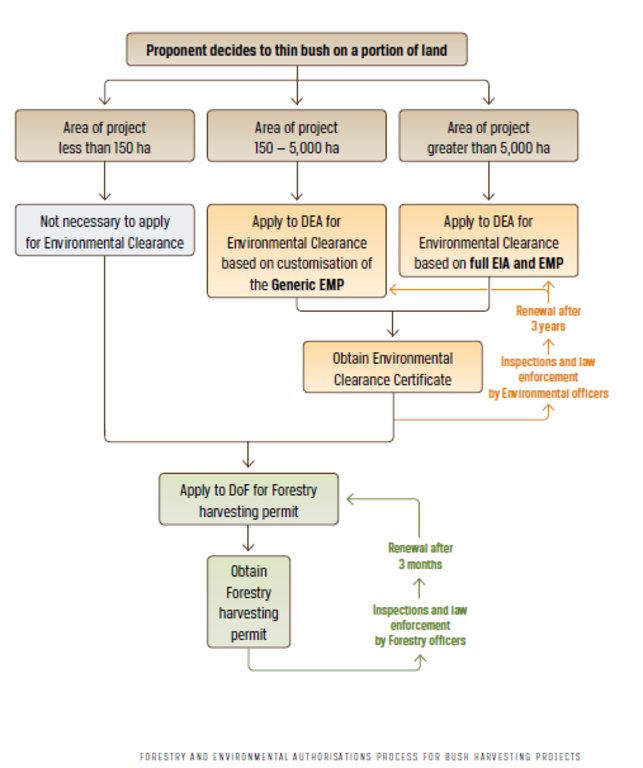Bush Control and Biomass Utilisation [Namibie]
- Création :
- Mise à jour :
- Compilateur : Johannes Laufs
- Rédacteur : Asellah David
- Examinateurs : Rima Mekdaschi Studer, Joana Eichenberger
Bush Control and Biomass Utilisation
approaches_2809 - Namibie
Voir les sections
Développer tout Réduire tout1. Informations générales
1.2 Coordonnées des personnes-ressources et des institutions impliquées dans l'évaluation et la documentation de l'Approche
Spécialiste GDT:
Gschwender Frank
frank.gschwender@giz.de
Deutsche Gesellschaft für Internationale Zusammenarbeit (GIZ)
Nom du projet qui a facilité la documentation/ l'évaluation de l'Approche (si pertinent)
GIZ Support to De-bushing ProjectNom du projet qui a facilité la documentation/ l'évaluation de l'Approche (si pertinent)
Book project: Guidelines to Rangeland Management in Sub-Saharan Africa (Rangeland Management)Nom du ou des institutions qui ont facilité la documentation/ l'évaluation de l'Approche (si pertinent)
Deutsche Gesellschaft für Internationale Zusammenarbeit (GIZ)1.3 Conditions relatives à l'utilisation par WOCAT des données documentées
Quand les données ont-elles été compilées (sur le terrain)?
01/06/2015
Le compilateur et la(les) personne(s) ressource(s) acceptent les conditions relatives à l'utilisation par WOCAT des données documentées:
Oui
2. Description de l'Approche de GDT
2.1 Courte description de l'Approche
Public and private stakeholders in Namibia are cooperating in the national Bush Control and Biomass Utilisation programme. There are three components: (1) Creation of an enabling framework, (2) Advisory Services and (3) Value Chain Development.
2.2 Description détaillée de l'Approche
Description détaillée de l'Approche:
Namibia is affected by bush encroachment on a massive scale: it affects some 45 million hectares in 9 of the 14 regions. Bush encroachment has lowered the carrying capacity of rangeland by up to two thirds. It further severely reduces biodiversity and limits the recharge of groundwater.
Various factors contribute to the acceleration of bush encroachment. A primary cause is overgrazing: the grass layer loses its competitive advantage and greater infiltration of water and nutrients into the sub-soil results, benefiting bush and tree species. Other factors are the reduction in the frequency of wildfires, and the exclusion of wildlife browsers through fencing for livestock.
The “state-and-transition model” describes how savannah ecosystems are event-driven, where rainfall variation impacts on vegetation growth and its composition. Woody plants establish themselves after dry periods followed by a few wet years, and then maintain themselves by utilizing most of the water. But a savannah can be changed back to its grass-dominated state by management or favorable environmental conditions.
Bush encroachment is accompanied by the loss of perennial grasses, which are replaced by annuals of inferior quality and productivity – thus livestock production becomes precarious and less sustainable.
Despite its negative impacts, the encroaching bush has developed into a huge surplus biomass resource, estimated at about 200 to 300 million tonnes. Measures used to combat bush encroachment create positive opportunities for the Namibian economy, such as the use of the resource for power generation and value chain development in other sectors.
Bush harvesting therefore offers the potential to increase economic growth, employment and energy security, while benefiting agriculture and food production.
In line with national development plans, which promote domestic value addition for local resources, the approach strengthens the restoration of productive rangeland. It triggers and drives large-scale bush thinning activities.
The programme will foster institutional development in the biomass sector and provide support to improve the legal and regulatory framework for the upscaling of bush control. It has three components:
(1) Creation of an enabling framework: harmonization of sector policies and improvement of relevant regulations; strengthening of institutional capacities.
(2) Advisory Services: strengthening of existing farmer outreach services and knowledge dissemination to farmers, businesses and public sector decision makers.
(3) Value Chain Development: identification and piloting of relevant value chains for encroacher bush as a trigger for bush control.
It is implemented through a collaboration of public and private stakeholders. Coordination is ensured through a cross-sector steering committee, which includes the Ministries of National Planning (chair), Agriculture, Environment, Energy, and Industrialisation.
Key outputs of the programme include:
Enabling Environment:
- Strategic Environmental Assessment (SEA)
- Introduction of Harvesting Authorisations Guidelines
- Development of dedicated financial products (loan subsidy schemes).
Institutions:
- Introduction of the De-bushing Advisory Service (DAS)
- Introduction of the Namibia Biomass Industry Group (N-BiG)
- Re-organisation of the Namibia Charcoal Association (NCA).
Knowledge:
- Compilation of baseline data on bush encroachment and bush control
- Technical know-how on value chain technologies and concepts
- Compilation of relevant regulations and environmental principles.
Value Chain Development:
- Piloting of various value chains, including modernized charcoal production, bush based animal feed and household cooking fuel.
2.3 Photos de l'approche
2.5 Pays/ région/ lieux où l'Approche a été appliquée
Pays:
Namibie
Région/ Etat/ Province:
Bush control is applied across Namibia on many privately owned farms. Activities are most concentrated in the regions of Khomas, Omaheke, Otjozondjupa and Oshikoto.
Autres spécifications du lieu :
Pointers indicate hotspots (e.g. urban centres) around which activities are concentrated. It is not possible to depict each site where bush control is implemented due to the high number of individual activities and because no GIS based mapping has been conducted.
Map
×2.6 Dates de début et de fin de l'Approche
Indiquez l'année de démarrage:
2014
Si l'année précise est inconnue, indiquez approximativement quand l'Approche a démarré:
il y a moins de 10 ans (récemment)
Date (année) de fin de l'Approche (si l'Approche n'est plus appliquée):
2021
2.7 Type d'Approche
- fondé sur un projet/ programme
2.8 Principaux objectifs de l'Approche
Develop, test and upscale the implementation of bush control technologies in Namibia.
2.9 Conditions favorisant ou entravant la mise en œuvre de la(des) Technologie(s) appliquée(s) sous l'Approche
normes et valeurs sociales/ culturelles/ religieuses
- favorise
Awareness of the need to implement bush control across all stakeholder groups.
- entrave
Low level of cooperation and information exchange.
disponibilité/ accès aux ressources et services financiers
- entrave
Limited variety of dedicated/customized financial products available; cost of finance high.
cadre institutionnel
- entrave
Low level of cross-sector coordination and limited funding sources for sector representative bodies (e.g. associations).
collaboration/ coordination des acteurs
- entrave
Low level of interaction and knowledge sharing.
cadre juridique (régime foncier, droits d'utilisation des terres et de l'eau)
- favorise
Clear land tenure in commercial areas and suitable concepts in communal areas (e.g. conservancies and community forests).
cadre politique
- entrave
Low level of policy harmonization across sectors; need to resolve conflicting mandates of relevant authorities (e.g. industrialization vs. resource protection).
gouvernance foncière (prise de décisions, mise en œuvre et application des décisions)
- favorise
Clear governance and management in commercial areas.
- entrave
Unclear decision-making processes for income generating projects in communal areas.
connaissances sur la GDT, accès aux supports techniques
- entrave
Low level of bush control know how among land owners.
marchés (pour acheter les intrants, vendre les produits) et prix
- favorise
High national and international demand for woody products.
charge de travail, disponibilité de la main-d'œuvre
- entrave
Low level of skills among workers.
3. Participation et rôles des parties prenantes impliquées dans l'Approche
3.1 Parties prenantes impliquées dans l'Approche et rôles
- exploitants locaux des terres / communautés locales
Commercial farmers, communal farmers, conservancies
Implementation of bush control and/or availing land for bush control and biomass utilisation activities
- organisations communautaires
conservancies, community forests
Implementation of bush control and/or availing land for bush control and biomass utilisation activities
- Spécialistes de la GDT/ conseillers agricoles
Farmer outreach services and independent experts
Dissemination of information and skills development
- chercheurs
Namibia University of Science (NUST), University of Namibia (UNAM)
Complementary research projects
- secteur privé
Namibia Biomass Industry Group (N-BiG), Namibia Charcoal Association (NCA)
Representation of corporates involved in bush harvesting and biomass value addition.
- gouvernement national (planificateurs, décideurs)
National Planning Commission (NPC)
Ministry of Agriculture, Water and Forestry (MAWF)
Ministry of Environment and Tourism (MET)
Ministry of Mines and Energy (MME)
Ministry of Industrialisation and SME Development (MITSMED)
Policy and strategy development; sector steering; law enforcement, monitoring and evaluation.
- organisation internationale
Deutsche Gesellschaft für Internationale Zusammmenarbeit (GIZ), KfW, EIB, UNDP
Implementation of bilateral cooperation projects
3.2 Participation des exploitants locaux des terres/ communautés locales aux différentes phases de l'Approche
| Participation des exploitants locaux des terres/ communautés locales | Spécifiez qui était impliqué et décrivez les activités | |
|---|---|---|
| initiation/ motivation | auto-mobilisation | High awareness and mobilisation within the farming community. |
| planification | interactive | Good participation in public workshops and conferences. |
| mise en œuvre | auto-mobilisation | Implementation of bush control by individual farmers. |
| suivi/ évaluation | passive | Very limited monitoring and evaluation through individual land owners. |
3.3 Diagramme/ organigramme (si disponible)
Description:
Legal and regulatory framework for large scale bush control: the flow chart explains the three levels of categories for the Environmental Clearance process. The categories are as follows:
- Small bush harvesting operations covering less than 150 ha: no environmental clearance required
- Medium bush harvesting operations covering between 150 and 5 000 ha: environmental clearance based on a generic Environmental Management Plan (EMP) is needed
- Large bush harvesting operations of more than 5 000 ha, Environmental Clearance based on Environmental Impact Assessment (EIA) and Environmental Management Plan (EMP)
Abbreviations:
DEA - Directorate of Environmental Affairs, Ministry of Environment and Tourism
DoF - Directorate of Forestry, Ministry of Agriculture, Water and Forestry
EIA - Environmental Impact Assessment
EMP - Environmental Management Plan
ha - hectares
Auteur:
GIZ Support to De-bushing Project (2016)
3.4 Prises de décision pour la sélection de la Technologie/ des Technologies
Indiquez qui a décidé de la sélection de la Technologie/ des Technologies à mettre en œuvre:
- tous les acteurs concernés dans le cadre d'une approche participative
Spécifiez sur quelle base ont été prises les décisions:
- l'évaluation de connaissances bien documentées en matière de GDT (prises de décision fondées sur des preuves tangibles)?
- les résultats de recherches?
- expériences et opinions personnelles (non documentées)
4. Soutien technique, renforcement des capacités et gestion des connaissances
4.1 Renforcement des capacités/ formation
Une formation a-t-elle été dispensée aux exploitants des terres/ autres parties prenantes?
Oui
Spécifiez qui a été formé:
- personnels/ conseillers de terrain
Formats de la formation:
- sur le tas
- zones de démonstration
- réunions publiques
Thèmes abordés:
- Environmental and forestry policy and policy emplementation (training for government officials from regional offices)
- Implementation of bush control and biomass processing (training for farmers and SMEs)
4.2 Service de conseils
Les exploitants des terres ont-ils accès à un service de conseils?
Oui
Spécifiez si le service de conseils est fourni:
- dans des centres permanents
Décrivez/ commentez:
Advisory services through the De-bushing Advisory Service (DAS, www.dasnamibia.org)
4.3 Renforcement des institutions (développement organisationnel)
Des institutions ont elles été mises en place ou renforcées par le biais de l'Approche?
- oui, beaucoup
Spécifiez à quel(s) niveau(x), ces institutions ont été renforcées ou mises en place:
- national
Décrivez l'institution, ses rôles et responsabilités, ses membres, etc.
Launch of
- De-bushing Advisory Service (DAS)
- Namibia Biomass Industry Group (N-BiG)
Re-organisation of
- Namibia Charcoal Association (NCA)
Précisez le type de soutien:
- financier
- renforcement des capacités/ formation
- équipement
- Institutional Development
Donnez plus de détails:
Three sector institutions have been supported in order to achieve increased coordination of efforts. The Namibia Biomass Industry Group (N-BiG) is a non-profit association, representing the interest of bush harvesting and processing companies. The De-bushing Advisory Service (DAS) is a national platform for the dissemination of knowledge on the topics of bush encroachment, bush control and biomass utilisation.
The Namibia Charcoal Association (NCA) represents the already well established charcoal production sector. Through a re-organisation process, the association has been strengthended and turned into a fully functioning sector representation.
The three organisations are planned to consolidate their efforts in the near future in order to achieve a better alignment of their mandates and synergies of activities.
4.4 Suivi et évaluation
Le suivi et l'évaluation font ils partie de l'Approche? :
Oui
Commentaires:
National Bush Information System
- Scope of bush encroachment
- Scope of bush control activities
- Success rate of bush control methodologies, incl. secondary impacts (employment)
Si oui, ce document est-il destiné à être utilisé pour le suivi et l'évaluation?
Non
4.5 Recherche
La recherche a-t-elle fait partie intégrante de l’Approche?
Oui
Spécifiez les thèmes:
- économie/ marketing
- écologie
- technologie
Donnez plus de détails et indiquez qui a mené ces recherches:
Collaboration with scientific institutions and networks on:
- Identification and development of suitable technology
- Correlation with ecosystem services, e.g. grounwater recharge and biodiversity
- Identification of market for bush based products.
5. Financement et soutien matériel externe
5.1 Budget annuel de la composante GDT de l'Approche
Si le budget annuel précis n'est pas connu, indiquez une fourchette:
- > 1 000 000
Commentez (par ex. principales sources de financement/ principaux bailleurs de fonds):
Pooling of resources between national government, international donors and private sector.
5.2 Soutiens financiers/ matériels fournis aux exploitants des terres
Les exploitants des terres ont-ils reçu un soutien financier/ matériel pour la mise en œuvre de la Technologie/ des Technologies?
Non
5.3 Subventions pour des intrants spécifiques (incluant la main d'œuvre)
- aucun
Si la main d'œuvre fournie par les exploitants des terres était un intrant substantiel, elle était:
- volontaire
5.4 Crédits
Des crédits ont-ils été alloués à travers l'Approche pour les activités de GDT?
Oui
Spécifiez les conditions (taux d'intérêts, remboursements, etc.):
Commercial loans with grace period of up to 3 years and interest rate of 7-8%.
Spécifiez les fournisseurs du crédit:
Commercial banks: First National Bank (FNB), Agribank
Development Bank of Namibia (DBN)
Environmental Investment Fund (EIF).
Spécifiez les destinataires du crédit:
- Individual households/farmers
- Service providers/business
5.5 Autres incitations ou instruments
D'autres incitations ou instruments ont-ils été utilisés pour promouvoir la mise en œuvre des Technologies de GDT?
Oui
Si oui, spécifiez:
Development of authorisations guidelines and review of regulations with regard to Environmental Management Plans (EMPs) and Environmental Impact Assessments (EIAs).
6. Analyses d'impact et conclusions
6.1 Impacts de l'Approche
Est-ce que l'Approche a autonomisé les exploitants locaux des terres, amélioré la participation des parties prenantes?
- Non
- Oui, un peu
- Oui, modérément
- Oui, beaucoup
Increased dissemination of information and exchange between land users on experiences with technologies; stakeholder representation through associations and participation in high level national conferences.
Est-ce que l'Approche a permis la prise de décisions fondées sur des données probantes?
- Non
- Oui, un peu
- Oui, modérément
- Oui, beaucoup
Various publications to capture best practices in bush control and biomass utilisation, including farmers manuals.
Est-ce que l'Approche a aidé les exploitants des terres à mettre en œuvre et entretenir les Technologies de GDT?
- Non
- Oui, un peu
- Oui, modérément
- Oui, beaucoup
Development of various guidelines
Est-ce que l'Approche a amélioré la coordination et la mise en œuvre de la GDT selon un bon rapport coût-efficacité?
- Non
- Oui, un peu
- Oui, modérément
- Oui, beaucoup
Improvement of cross-sector collaboration through steering committee.
Est-ce que l'Approche a mobilisé/ amélioré l'accès aux ressources financières pour la mise en œuvre de la GDT?
- Non
- Oui, un peu
- Oui, modérément
- Oui, beaucoup
Involvement of financial institutions with the aim to develop customised financial products.
Est-ce que l'Approche a amélioré les connaissances et les capacités des exploitants des terres pour mettre en œuvre la GDT?
- Non
- Oui, un peu
- Oui, modérément
- Oui, beaucoup
Various publications to capture best practices in bush control and biomass utilisation, including farmers manuals.
Est-ce que l'Approche a amélioré les connaissances et les capacités des autres parties prenantes?
- Non
- Oui, un peu
- Oui, modérément
- Oui, beaucoup
Increase awareness of the opportunity of the biomass resource among public sector stakeholders as well as within the business community.
Est-ce que l'Approche a construit/ renforcé les institutions, la collaboration entre parties prenantes?
- Non
- Oui, un peu
- Oui, modérément
- Oui, beaucoup
Through introduction of steering committee, working groups as well as through the strengthening of sector representative bodies/associations.
Est-ce que l'Approche a autonomisé les groupes socialement et économiquement défavorisés?
- Non
- Oui, un peu
- Oui, modérément
- Oui, beaucoup
Employment creation in bush control and biomass utilisation, e.g. in charcoal production.
Est-ce que l'Approche a amélioré l'égalité entre hommes et femmes et autonomisé les femmes et les filles?
- Non
- Oui, un peu
- Oui, modérément
- Oui, beaucoup
Promotion of dedicated employment opportunities for women, e.g. in charcoal packaging.
Est-ce que l'Approche a conduit à améliorer l'accès à l'eau et l'assainissement?
- Non
- Oui, un peu
- Oui, modérément
- Oui, beaucoup
Improved groundwater recharge in bush controlled areas. Research is ongoing and first results indicate a significantly improved infiltration of rainwater into the groundwater. The reduced number of bushes leads to reduced evapotranspiration.
Est-ce que l'Approche a conduit à l'utilisation/ sources d'énergie plus durables?
- Non
- Oui, un peu
- Oui, modérément
- Oui, beaucoup
First biomass energy projects launched (industrial heating) and in preparation (national grid electricity production).
Est-ce que l'Approche a conduit à des emplois, des opportunités de revenus?
- Non
- Oui, un peu
- Oui, modérément
- Oui, beaucoup
Employment in bush harvesting and processing, especially in charcoal production.
6.2 Principale motivation des exploitants des terres pour mettre en œuvre la GDT
- augmenter la production
Need for bush control in order to increase carrying capacity of land.
- réduire la dégradation des terres
Rehabilitation of land through bush thinning.
6.3 Durabilité des activités de l'Approche
Les exploitants des terres peuvent-ils poursuivre ce qui a été mis en œuvre par le biais de l'Approche (sans soutien extérieur)?
- oui
Si oui, décrivez de quelle manière:
Land users have the capacity to implement bush control, either with own means (mainly manual and semi-mechanised bush harvesting) or through the involvement of service providers (mainly fully mechanised bush harvesting for the supply of large-scale off-takers).
6.4 Points forts/ avantages de l'Approche
| Points forts/ avantages/ possibilités du point de vue de l'exploitant des terres |
|---|
| Financial viability of bush control through the introduction of value chains (as compared to mere removal of the biomass). |
| Improved access to information and know how. |
| Improved advocacy/ communication with government authorities. |
| Points forts/ avantages/ possibilités du point de vue du compilateur ou d'une autre personne ressource clé |
|---|
| Mindshift among public and decision makers from focus on the challenge (bush encroachment) to the opportunities (value addition). |
| Cross-sector cooperation through steering committee. |
| Involvement of private sector as driving force for implementation. |
6.5 Faiblesses/ inconvénients de l'Approche et moyens de les surmonter
| Faiblesses/ inconvénients/ risques du point de vue de l’exploitant des terres | Comment peuvent-ils être surmontés? |
|---|---|
| Limited direct (financial) support. | Introdution of incentive schemes. |
| Limited opportunities in remote areas, i.e. when distance to biomass off-takers is too large. | Further development of on-farm solutions (e.g. bush-to-feed). |
| Faiblesses/ inconvénients/ risques du point de vue du compilateur ou d'une autre personne ressource clé | Comment peuvent-ils être surmontés? |
|---|---|
| Complex programme steering requirements, due to multi-sector relevance. The national programme for Bush control and Biomass Utilisation is currently anchored in the Directorate of Forestry (DoF) of the Ministry of Agriculture. This adequately accounts for the fact that the bush resource is part of the national forestry/biomass resource and its utilisation must be regulated as such. However, this anchoring does not allow for an effective promotion of biomass utilisation (e.g. SME promotion, industrialisation concepts, development of logistics hubs) and innovative end-uses (e.g. development of biomass power plants). For this purpose other line ministries, such as Ministry of Mines and Energy (MME) as well as Ministry of Industrialisation and SME Development (MITSMED) are part of the programme's steering committee. | Establishment of national coordinating body to formalise the current steering committee. |
7. Références et liens
7.1 Méthodes/ sources d'information
- interviews/entretiens avec les exploitants des terres
- interviews/ entretiens avec les spécialistes/ experts de GDT
7.2 Références des publications disponibles
Titre, auteur, année, ISBN:
Baseline Assessment for the De-bushing Programme in Namibia (2014)
Disponible à partir d'où? Coût?
GIZ Support to De-bushing Project, www.dasnamibia.org/downloads
Titre, auteur, année, ISBN:
GIZ Support to De-bushing Project (2016)
Disponible à partir d'où? Coût?
Strategic Environmental Assessment of Large-Scale Bush Thinning and Value Addition Activities in Namibia, www.dasnamibia.org/downloads
7.3 Liens vers les informations pertinentes disponibles en ligne
Titre/ description:
De-bushing Advisory Service (DAS) Namibia, Resource Section
URL:
www.dasnamibia.org/downloads
Titre/ description:
Namibia Biomass Industry Group (N-BiG)
URL:
www.n-big.org
Titre/ description:
Namibia Charcoal Association (NCA)
URL:
www.ncanamibia.com
Liens et modules
Développer tout Réduire toutLiens
Aucun lien
Modules
Aucun module trouvé


